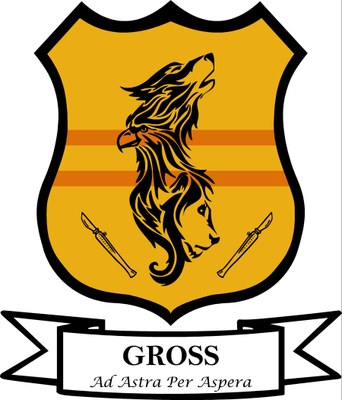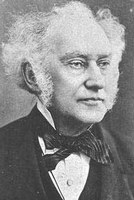Gross College
 In the 1840s, the newly founded University of Louisville attracted an outstanding faculty that was second to none anywhere in the world. Among that faculty, Samuel David Gross, MD (1805-1884) would achieve the greatest national and international acclaim, and he would come to rank among the greatest surgeons of the 19th century.
In the 1840s, the newly founded University of Louisville attracted an outstanding faculty that was second to none anywhere in the world. Among that faculty, Samuel David Gross, MD (1805-1884) would achieve the greatest national and international acclaim, and he would come to rank among the greatest surgeons of the 19th century.
Samuel Gross was born near Easton, Pennsylvania, to a farm family whose first language was Pennsylvania Dutch, a German dialect. His early interest in medicine was frustrated by lack of basic education, so his early mentor, Dr. Joseph Swift, sent him for classical studies before bringing him back as his apprentice. Swift then directed Gross to complete formal medical training. Gross chose Philadelphia’s Jefferson Medical College because of luminary professors John Eberle, MD, in medicine, and George McClellan, MD, in surgery. Gross graduated in 1828 and returned to Easton for practice. There, Gross showed his scientific spirit, rare in those times, by constructing a laboratory behind his home to regularly engage in anatomic dissections and in medical experimentation. Aspirations to teach anatomy were fulfilled in 1833, when his mentor, John Eberle, MD, became Professor at Cincinnati’s Medical College of Ohio, and appointed Gross as anatomy demonstrator. Jealousy from the Anatomy Chair redirected him to the nearby Cincinnati College Medical Department, which had just been founded by Daniel Drake, MD. There, Gross and Drake would establish mutual admiration and a lifelong friendship. In 1839, Gross published Elements of Pathological Anatomy, which gained wide acclaim, including praise from the great German pathologist Rudolf Virchow, MD. The Cincinnati College’s Medical Department collapsed in 1839, and Drake was recruited to the newly founded Louisville Medical Institute that year. Gross followed in 1840.
Alongside his surgery professorship, Gross established a robust practice at St. Vincent Infirmary, then on Jefferson Street, which later became St. Joseph’s Infirmary. He was a technical master and a fanatic on cleanliness. Before Pasteur had discovered the germ theory of disease, Gross believed surgical infections to be caused by yet unknown pathogens transmitted on surgeons’ hands and instruments. His U of L tenure lasted 16 years, except for one year in New York. During those years, Gross and colleagues raised U of L to an exceptional international reputation. He was as outstanding teacher and gave dramatic, highly interesting lectures and rounds. Gross established the first U of L experimental laboratory in the new medical school basement to study intestinal wounds. The fleas brought by his canine “subjects” spread building-wide and drew much commentary from faculty and students. However, these experiments produced a classic surgery textbook in 1843, An Experimental and Critical Inquiry Into the Nature and Treatments of Wounds of the Intestines. His subsequent classic, widely read books were on diseases and injuries of the bladder, prostate and urethra in 1851, and on foreign bodies in the air passages in 1854. Much of the work on his great, two-volume System of Surgery (1859) was done in Louisville.
 He was a founder and third President of the Kentucky State Medical Association. An avid historian, his research on pioneer Kentucky surgeon Ephraim McDowell, M.D., made a memorable contribution by making known McDowell’s historic first abdominal operation. Gross and his wife became civic leaders and were popular in leading social circles. In the deplorable, anti-immigrant, voter suppression, Bloody Monday riots of 1855, Unitarian Gross joined his friend, Mayor John Barbie, in saving the Cathedral of the Assumption from a bigoted mob intent on burning it.
He was a founder and third President of the Kentucky State Medical Association. An avid historian, his research on pioneer Kentucky surgeon Ephraim McDowell, M.D., made a memorable contribution by making known McDowell’s historic first abdominal operation. Gross and his wife became civic leaders and were popular in leading social circles. In the deplorable, anti-immigrant, voter suppression, Bloody Monday riots of 1855, Unitarian Gross joined his friend, Mayor John Barbie, in saving the Cathedral of the Assumption from a bigoted mob intent on burning it.
In 1856, Gross left to become Chair of Surgery at his alma mater, Jefferson Medical College. At Jefferson, Gross’ career and reputation continued to prosper. He helped found the American Surgical Association and twice became American Medical Association President, first in 1868, and again at the 1875 Louisville meeting. At the AMA, he helped to transform the AMA Transactions into the modern Journal of the American Medical Association. In 1875, artist Thomas Eakins painted The Gross Clinic, a masterpiece of realism that shows Gross commanding an amphitheater surgery and teaching in his dramatic style. In 1884, Gross died in Philadelphia at age 78. He stands among the finest master surgeons and medical educators of all time, and he contributed enormously to the fine reputation of the young University of Louisville.
- Gordon R. Tobin, M.D.